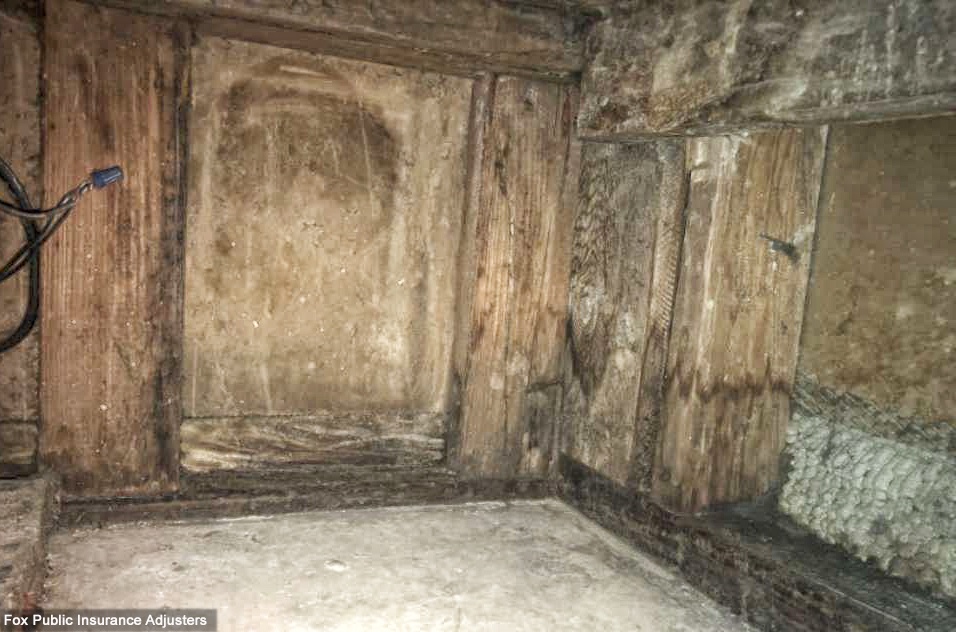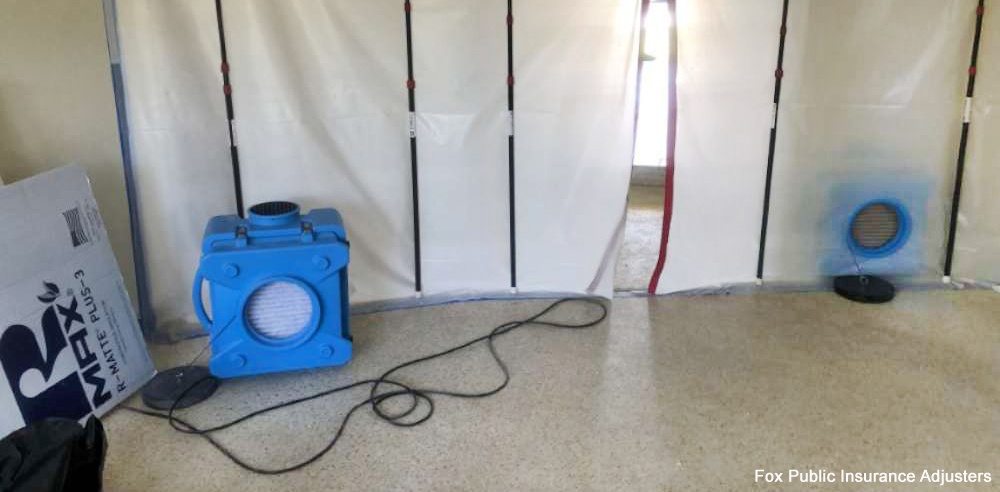Working as a public insurance adjuster in South Florida, we see mold damage issues over and over again. Many people believe that the method for mold removal in Florida is simple. A little bleach mixed with water and a lot of scrubbing. Nothing could be further from the truth. There are major health hazards that may result from improper attempts at removing mold from a home. At Fox Public Insurance Adjusters we are experts at handling mold issues. We work for the homeowner to assess the situation, give proper advise, and handle your South Florida insurance issues.

Once a homeowner called us because of a discolored crack on their Boca Raton living room wall. Before calling us, they called their insurance company. The insurance company sent out a wall and roof repair person that conducted an inspection. The homeowner was told that the roof had a leak, and the wall could simply be spackled and painted after the roof was repaired. Over the following days, the roofing person arrived and fixed the roof. Later a painter spackled and painted the wall. Once the job was finished everything looked great.
After several months had passed, someone in the home caught a cold, or so they thought. They took the usual cold medicines such as Tylenol Cold, Mucinex, Vicks and the cold symptoms disappeared. Then several weeks later, that pesky cold came back. This time it didn’t go away so easily. Finally a trip to the doctor was needed. The doctor prescribed an antibiotic to rid the person of a bacterial infection. Over the next weeks the symptoms remained and the person decided to meet with an allergist. The allergist ran a set of tests and found that the patient was allergic all sorts of things such as horses, grass, and wool. It didn’t seem that any of those things were possible fits, so it was determined it was just allergies. The doctor told the patient that here in South Florida there are so many allergens that it’s almost impossible the find the culprit. More time passed and the symptoms came and went. Sometimes the symptoms required the help of a nebulizer, which worked really well. This went on for months. Then a huge rainstorm hit Boca Raton and slight discoloring started to appear where the old living room wall cracks once were. This time the insurance company sent only a painter. Suspecting that there was more going on with this wall crack, they called us, the South Florida public insurance adjuster.
Then we followed the crack up to a part of the roof that runs along the side of the house. What we realized, is that the leak was not just on the roof but also along the inside wall. The previous insurance repair person only fixed the roof; they didn’t follow the damage along to the wall. Since the crack was inside the wall, water entering through the crack didn’t touch the inside drywall. The moisture only stayed along the inside the backside of the living room wall. Once we cut out the drywall in the living room, we found hidden mold growing against the inside of the home’s exterior wall. As it turned out, the recent very heavy rainstorm hit with enough force that water leaked through the exterior wall, and caused new water spot to appear. As s result of our visit, the inside drywall was removed and the mold cleared away and the walls were treated with an antimicrobial chemical.

Once we confirmed the mold was naturalized by using a particle scanner and our infrared camera, we knew the job was complete.
This is just one way mold can start and grow inside a home. In another case, the homeowner had an upstairs shower renovated. Everything was fine for several months. Then the homeowner started smelling a musty rotten wood smell in the kitchen downstairs. At first they thought it was old food in the pantry that was going bad. After investigating further, they found the inside of the pantry was wet. They then called a plumber who figured out that the shower pan was leaking. It turned out that the water from the shower was slowly dripping through the upstairs bathroom floor and then through the ceiling and into the pantry. The smell was awful and a mold remediation company had to be called in.
Mold loves living in South Florida
Anyone who lives here in South Florida knows that the South Florida climate is much more humid than most other parts of the country. This means that it only takes a small bit of additional water or flood damage to start mold growing quickly. Many people move to South Florida because they want to live close to the ocean. While waking up to a wonderful ocean view each morning is a fantastic lifestyle, living in a home by the ocean means that home mold issues are a constant threat. Because we are well known public insurance adjusters we see this situation often. We are also experienced when a home requires mold removal in South Florida.
Many people who have not experienced mold in their life or home believe mold in your home is no big deal. A little beach and water would solve the problem, correct. Actually no, using bleach and water on mold could make the situation worse and dangerous. As experts in Mold removal in South Florida we have seen a wide range of mold home issues. Sometimes the mold damage in minimal, other times homes have major damage. It takes a professional to determine the extent of the South Florida home damage and determine the best course of action.
If you believe you have a mold problem please call us for your free damage assessment. We service all of South Florida including West Palm Beach, Jupiter, Palm Beach Gardens, Lake Worth, Boynton Beach, Delray Beach, Boca Raton, Pompano Beach, Fort Lauderdale, Deerfield Beach, Stuart, and Port St. Lucie.
There is no charge for our service and we are always happy to help with your home damage needs. Our phone number is (561) 789-4369
How mold starts and grows
Here in South Florida, mold can start to grow within 24 hours on any damp or wet surface. The growing of mold involves the natural production of tiny organic seeds. These seeds or (spores) are so lightweight they can travel through the air and attach to any nearby surface. Because mold is made up of tiny living organisms, mold has a hungry appetite. The second mold starts to grow, it starts eating. Molds eat the sugar and starches inside the walls of your home. Once mold eats all the sugars and starches, it finds fresh food, what is left behind is a soft flaky smelly mess. Once this starts a homeowner should call a professional mold removal in South Florida expert because this will become a situation that is much more difficult for most homeowners to handle with out outside help.
Remember, mold isn’t like dirt, mold is a living organism that is going to do its best to survive and grow, it will always look for a way to keep expanding through your home. In its own dark musty world, mold will keep growing until it runs out of food or its environment changes and all the entire mold spores are killed, you don’t want to share your home with mold. Because mold loves to grow in dark wet places, it’s important to remember that if you have a wet leak inside a wall, mold will grow and eat away at you home. In addition to growing and eating the structure of your home, those super lightweight seeds or spores will become air-born. Those spores can travel all throughout your home. Once inhaled, those seeds or spores will produce a wide range of symptoms. These symptoms can include itchy eyes, coughs, asthma and a wide range of other unpleasant illnesses. Often people have no idea why they are becoming sick, and the mold problem is often found by accident. Because mold such a sneaky guest, it’s very important to hire a mold removal in Florida expert whenever your home experiences water or flood damage.
Check out this video. Todd was called because the homeowner had water damage behind a vanity in the bathroom wall. When Todd removed the vanity guess what he found? Mold in the bathroom
Todd at Fox Public Adjusters is an expert in both the home damage and mold issues. I have heard from many homeowners who have hired Todd, that he can smell mold in a home within a few seconds of entering a house. As a public insurance adjuster, Todd is you one stop remedy for home damage and insurance company issues.
Based in South Florida, Fox Public Adjusters serves homeowners in West Palm Beach, Jupiter, Palm Beach Gardens, Lake Worth, Boynton Beach, Delray Beach, Boca Raton, Pompano Beach, Fort Lauderdale, Deerfield Beach, Stuart and Port St. Lucie.
There is no fee to have Todd visit with you in your home. During Todd’s visit he will assess your homes water damage and recommend the best solution.

Types of Mold
Before any mold removal can begin, it’s critical for a professional mold remediator to identify the type of mold and then build a process to remove the specific type of mold present in your home. Because different types of molds respond differently to different treatments each home mold case is unique. There is a specific process for removing each different type of mold. In addition, some types of mold are more toxic than others. Here are the most common types of mold found in a South Florida home.
1 – Acremonium
This mold starts out as a powdery substance that could be several different colors. The colors of this mold range from pink, orange, grey or white. It’s a toxic mold that has been known to grow along with other types of mold. Because it turns into a powder it can easily become airborne and take other types of mold along for a ride as well.
2- Alternaria
If you are experiencing symptoms such as coughing, watery eyes this type of mold could be the culprit. Upon close inspection you will notice velvet like appearance with dark green and brown hairs. I would not advise the homeowner doing the close inspection. This mold spreads very quickly so quick action is required.
3- Aspergillus
This is another common toxic mold that grows in thick layers on home walls.
When you see this mold you will usually find it on wood surfaces. Its colors can range from pink to brown or black. I would strongly suggest that you don’t touch this mold because touching it will lead to various skin infections.
If you see a white or grey colored mold that resembles cotton. Over time it will turn black. It’s usually a result of serious water damage. Even though it looks like cotton, don’t touch it. Direct contact with this mold could lead to skin and nail infections.
6- Cladosporium
This olive green or brown mold tends to look like suede and is generally found on fabrics. A wet home carpet is the perfect place for this mold to live and grow. It’s known for causing allergic reactions and respiratory problems.
7- Fusarium
This is a really dangerous mold that should be avoided. It grows easily in wet damp environments. Luckily it doesn’t become airborne easily. However, if you touch it by accident and then touch your eyes or mouth you will develop serious flu-like symptoms. This mold is so nasty that in the 1930s and 40s the Soviet Union used it as a biological weapon. If this mold is found in your home it needs to be removed by a professional.
8- Mucor
This type of mold is most commonly found in home air conditioning units. If you have a leaking air conditioning unit, this mold may become present. Since it’s inside your air conditioning unit, the mold spores can enter your living environment by being pushed by the blowing air. The symptoms of this mold are the typical symptoms you would expect from other common molds. One extra precaution a homeowner can take is to install an air conditioner UV light unit. These units are installed inside the air conditioner’s air handlers. They kill all kinds of airborne molds that my originate inside your air conditioner. Having one of these units inside your air conditioner is not a solution to a serious mold problem. If mold is growing inside your AC unit a professional mold specialist will need to be called.
9- Penicillium
Blue or green in color, this mold has a velvety texture and is often found in water-damaged homes and offices. Because it’s easily airborne, it quickly finds its way into carpets, wallpaper and air conditioning ducting. It is easily inhaled and results in breathing issues. While this type of mold is used in the production of antibiotics, you don’t want this inside your home. After water damage this is the type of mold that easily develops.
This is one of the more dangerous types of molds that can be found in a water damaged home. It produces a wide range of illnesses including sinusitis, fatigue nose bleeds fever and very painful headaches. People who have been exposed to this type of mold have also experienced tightening in the chest and even depression. In addition it has become the cause of long lasting neurological problems in children. If you suspect you have this in your home, it’s important to remove children from the home and call a professional.
11 – Trichoderma
Eating through you home is what this mold accomplishes best. It looks like small round white and green chunks and grows on wet surfaces. Any surface that this mold grows on will most likely need to be removed and replaced. Once the mold gets into a piece of wood, it will grow from the inside causing the wood to crumble. It is common to find this mold inside air-conditioning filters and ac ducts in areas where water or condensation are present.
12-Ulocladium
This black mold is easily confused with other types of molds and it often grows in addition to other molds. It’s usually found in kitchens, bathrooms and basements.
In humans it causes a wide range of breathing problems and its symptoms are often taken as typical allergic reactions.
The mold removal process
The terms, mold removal, mold remediation, mold mitigation, and mold abatement all usually refer to the identifying, containing, and removal of the dangerous mold. This process is anything but simply cleaning up the mold. There is a process that must be followed to safely remove the mold and insure that the mold doesn’t grow back. While the mold removal in South Florida process follows the same steps with several different molds, it is sometimes different with other molds. Generally the process involves first finding the mold and removing or fixing the problems that started the mold growing process. Next all the mold-damaged materials must be removed. Professionals removing the mold-ridden items must be wearing protective gear such as gloves, masks, and goggles in order to avoid exposure.
Once the items containing mold are removed, the affected area should be sealed off from other parts of the home. Plastic sheets are usually used to seal off doorways and vents.
Next your mold remediation professional will create a negative airflow, which insures the airborne mold will not enter other parts of your home of office. Depending on the type of mold, a special fungicide will then be used to clean any remaining mold. In addition, there is a room dry out process, which involves commercial air movers and dehumidifiers combined with air scrubbers. These all work together to remove any moisture and kill the remaining mold spores. As you can see mold removal in South Florida requires specialized equipment that can detect mold and remove mold.

Often people assume that removing mold is simply a matter of using bleach and water to kill the mold and clean the area. This is a very bad idea because in many cases bleach will actually cause mold to grow even faster. A homeowner should never use bleach to clean mold. For more information on the subject click this article. Three reasons why using bleach to remove mold is a bad idea.
Mold can result from a damaged roof, broken plumbing pipe or drain, bad window seals, broken washing machine or dishwasher, or broken home gutters. It’s amazing how many ways a home could suffer water damage.

There is no charge to have us visit with you at your home and determine the best way to proceed with mold removal in South Florida. We serve all of South Florida including West Palm Beach, Jupiter, Palm Beach Gardens, Lake Worth, Boynton Beach, Delray Beach, Boca Raton, Pompano Beach, Fort Lauderdale, Deerfield Beach, Stuart and Port St. Lucie.
For more information on how we can help you with all of your South Florida public insurance adjuster needs check out this article which is filled with useful information. Should I hire a South Florida public adjuster?
As a Public Adjuster in South Florida we will work for you, the homeowner, by handling all your insurance damage claims. If you are having difficulty with your insurance companies adjuster or if you have received a poor settlement or if you have been denied a settlement call Todd at (561) 789-4369
